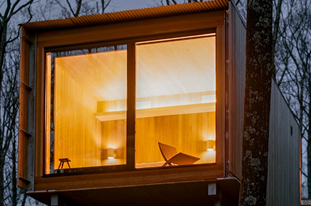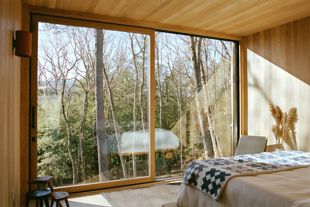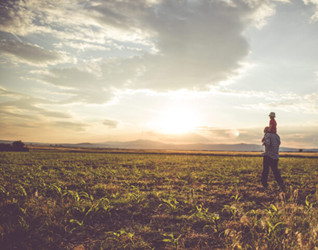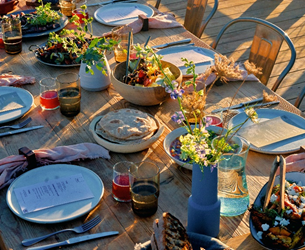The Segmentation Stage of Glamping
By Channing Henry and Alisher Nazir

Glamping, or nature-based travel more broadly, has become a proven part of the hospitality sector. Pre-Covid data from the World Travel & Tourism Council in 2019 shows that the nature-based tourism sector in North America had upwards of $25 billion in direct expenditure and contributed $13.5 billion to GDP, with a 2% share of the travel industry. COVID has changed the way people travel, increasing demand for nature-based hospitality, which reached an all-time high in Summer 2021. Kampgrounds of America (KOA) cited 260% growth in glamping among first-time camping households in North America from 2019 to 2020. The National Park visitation numbers recorded a 40% increase during Fall 2020 over the same period in 2019, with record-breaking numbers expected in 2021.These are just a few examples of a trend that is certain to continue.
Several operators – the big 4 – lead the industry in current and planned footprint. In alphabetical order, these are Autocamp, Collective Retreats, Getaway, and Under Canvas, all of which have raised over $250 million collectively by our accounts and have well over 3,000 units existing or planned. These operators are looking to put “dots on the map” and most are targeting a variety of outdoor destination and city-escape locations. Newer entrants that have loyal followings such as Firelight Camps in Ithaca and Sagra Farms in Sonoma have active development and expansion plans in the works. KOA has expanded into the higher end of its campground hospitality with its Terramor property in Maine. Others are coming in with proven models from elsewhere in the world to capture the highest end of the US market, established by a handful of operations priced above $2,500 per night in Utah, Montana, Colorado, and California.
Whether demand is driven by the desire to experience national and state parks from an authentic vantage point with open skies just outside the cabin door, a breeze through the tent flaps, stargazing with no light pollution; or a more engaged weekend outside of a city with prepared campfires, quality F&B packages, and adventure guides at the ready; the options have become plentiful. The industry has witnessed the growth of multiple product types (cabins, yurts, tents, RV’s and more), concepts, and the astonishing willingness for guests to pay a premium across the board.


Piaule Cabin Resort in Catskill, NY
Along with the extraordinary demand and emergence of new brands, come the complexities of development and financing known all too well in the more traditional sectors of the industry. Growth brings concerned community voices to the forefront, and more competition requires clearer value propositions for the consumer.
David Smith, Senior Director at Whitman Peterson, a leading backer of Autocamp, states “The biggest weakness of this cottage industry is that the barriers to entry are so low; anyone can put a tent in their backyard. There will be a moment of reckoning where consumers will stop paying for [less value]. Being novel will no longer be enough.”
Market segmentation is the natural evolution of this growth, and operators are wise to return to the fundamentals of the nature-based hospitality arena to maintain their success – namely a commitment to the people and surroundings in which they thrive. In doing so, more sustained long-term growth will be possible, and capital to support new development will follow.
Local Community is Key
In Joshua Tree, Autocamp builds on its growth story through connecting people with nature, and more importantly coexisting with nature through hospitality. To stay true to this vision, the 55-unit resort across 26 acres in Joshua Tree plans to re-vegetate the property upon completion with native cacti, Joshua trees and other plants. Other initiatives include limiting the volume of indoor space that needs air conditioning, low water usage, xeriscaping to avoid irrigation, on-site water treatment, heavy reliance on solar power (23-kilowatt solar system), and dark sky-compliant lighting to preserve the views of the night sky.
Though Autocamp strives to build this community through its various commitments, not every local community is satisfied with its development proposals. In May 2021, Autocamp withdrew a rezoning change request of 19 acres that faced development backlash from the local community in Sedona, Arizona. The operator was planning for 85 airstreams and a 4,500-sq ft clubhouse adjacent to a national forest. Citing fire risk concerns and permanent damage to the biodiversity, the Keep Sedona Beautiful Organization expressed worries regarding the environmental impact of such a development, particularly for property adjacent to wilderness.

Autocamp Joshua Tree, California
In June 2021, Under Canvas was faced with similar opposition from the local community of San Juan County, Utah, regarding their plan to develop a 220-acre, 75-tent operation adjacent to the Canyonlands National Park. Some concerns of the community were the fear that this development would put pressure on remote areas outside of the developed towns and cities, which eventually sparked a petition opposing the development.
Under Canvas has created their business model around promoting travel in nature, focusing largely on sites adjacent to National Parks. In addition to their efforts in promoting nature-based and experiential travel, Under Canvas creates valuable societal benefits reflected in local communities, particularly in promoting growth in employment and supporting local businesses, retailers, and farms. Within its four locations in Utah, the company is engaged in a land lease from The Utah School and Institutional Trust Lands Administration (SITLA). As a part of an existing arrangement with SITLA for each location, Under Canvas pays $100,000 annually plus 5% of gross revenues to the land trust. The glamping operator works with the requirements of the state, through which these funds are then used by SITLA to help fund Utah’s public schools.
Firelight Camps, in upstate New York, proactively engage in extensive conversations with local communities whilst also promoting a sustainable approach to development. The glamping operator had previously stepped away from a project in Sullivan County, NY, due to various entitlements and permitting issues. Currently, as a part of their development strategy, Firelight aims to renovate an existing under-performing campground in Phoenicia, NY, minimizing any additional environmental footprint. In June 2021, the group received its special use permit and site plan approval for the 80-unit glamping operation on a former 57-acre campground in Phoenicia, NY. The Mid-Hudson Regional Economic Development Committee labelled the project as ‘Regionally Significant’ and scored it highly according to the state’s environmental justice and workforce priorities.
Much like the protracted entitlements processes in places such as California, where neighborhood character and the protection of public resources are of utmost importance, local communities in beautiful and remote areas are gaining more voice and seeking land preservation measures from the new developments on the horizon.
Opportunity to Target ESG Funds
Guests also place high importance on preservation. According to a Booking.com annual travel report that surveys travelers across 30 countries, 83% think sustainable and eco-conscious travel is important. The survey notes the increasing trend among travelers intending to stay at least once in an eco-friendly or sustainable accommodation in the year ahead – from 62% in 2016 to 81% in 2021.
Amidst current climate disasters around the globe including extreme weather conditions, a global pandemic, and wildfires that are raging through natural habitats and forestry, the importance of biodiversity conservation and preserving our natural eco systems is recognized by more and more institutions every day. The economic threat of any potential climate disaster is clear. The World Economic Forum has estimated that approximately half ($44 trillion) of global GDP is highly or moderately dependent on nature.
By making a deeper commitment to sustainability, and in some cases even biodiversity conservation, nature-based hospitality owners and operators will open the door to capital from investors and funds involved in impact investing. Some of these necessary initiatives would include dedication to the UN Sustainable Development Goals (SDG), as well as the 2050 vision of the UN Convention on Biodiversity through measuring their environmental impact.
Certain institutional investors and private equity funds are increasing their commitments toward their impact investments. TPG’s ‘The Rise Fund’ invests in companies driving social and environmental impact and responsible growth across a multitude of industries. In 2018, the fund acquired a 34% stake in Wilderness Holdings, an eco-tourism and nature-based hospitality group with operations in seven African countries (Wilderness Safaris). Furthermore, in early 2021, TPG announced a new initiative with TPG Rise Climate Fund. In recent weeks the fund closed on $5.4 billion toward its inaugural fund which will be dedicated to constructing a portfolio of companies that can enable carbon aversion in a quantifiable way.
In the United Kingdom, private equity firm Foresight, with $10 billion of assets under management, is committed to growing small businesses around the UK and is actively measuring the impact of its investments through selected themes defined by the UN SDGs. In April 2021, the firm had injected just under $2 million of growth capital into the Scottish glamping pod operator FURTHER.SPACE. That operator carefully identifies its sites focusing on unique spaces in unexpected places with operations no larger than six pods. They work closely with independent landowners to diversify their revenue streams with their low-cost partnership model and have committed to growing their unit count to over 150 pods in the next few years.

FURTHER.SPACE, Killarney, Republic of Ireland
Although many of these initiatives exist, there is still a large gap in conservation financing. As Costa Rican Creo Capital outlines, according to the United Nations Development Programme in the Biodiversity Finance Catalogue of Finance Solutions, the Financing Nature 2020 report states that as of 2019, current spending on biodiversity conservation is between $124 and $143 billion per year, against a total estimated biodiversity protection need between $722 and $967 billion per year to put a stop to biodiversity loss – an enormous delta. Under its platform of Experiential Luxury Camps & Lodges across the country, the private investment firm and developer has directly committed to marine and animal conservation. It intends to allocate 5% of all revenues to well-vetted local organizations, while maintaining high standards of ESG principles across its operations.
ESG funds – those that are committed to Environmental, Social, and Governance goals – are now a recognized investment class across the globe. Funds from Blackrock to Goldman Sachs and those mentioned above are joined by countless family offices committed to creating a legacy through impact investing. Measures of success are being defined and redefined as data collection and the clarification of funds’ goals continue to improve. Nature-based hospitality has the opportunity to help shape those goals, create more profit while doing good, and open up more capital for future growth by aligning itself with these mutually beneficial goals.
Key Demand Drivers for Glamping

Collective Retreats, Vail, Colorado
Nature-Based and Experiential Travel - Alternative lodging immersed in nature including but not limited to cabins, tents, and airstreams adjacent to national parks and awe-inspiring natural sites
- According to KOA’s 2021 Camping Report, 32% of first-time campers chose to have a camping experience based on their love for the outdoors. Furthermore, TripAdvisor reported that in a recent survey, 59% of respondents prefer destinations that are off the beaten path with nature-based activities such as boating, canoeing, horse riding, and skiing.
Sustainable and Eco-Conscious Travel - A growing concern for the environment through an appreciation of the beauty of natural habitats and the ultimate goal of reducing the ecological footprint through more local travel and serious commitments to biodiversity conservation
- A 2019 National Geographic consumer survey of 3,500 adults in the US found that half of US travelers who prioritize sustainability in their travel decisions are 18-34 years old, with 66% of millennials saying that they are willing to pay more for services by companies committed to creating a positive environmental impact.
Wellness - Increased consciousness about our impact on the planet including healthy eating, nutrition, and a balanced lifestyle
- Within the $4.2 trillion global wellness economy, wellness tourism is a major component, growing from $640 billion in 2017 to a projected $1.1 trillion by 2028, according to Vision Research Reports. The Global Wellness Institute notes that wellness tourism is growing between 6.5% and 7.5% every year.
Community - The desire to connect and learn from people within local communities as well as from purposeful glamping travelers alike throughout common gathering areas such as a campfire, where knowledge can be shared, and new friendships are created
- Several hospitality companies continue to embrace the trend by incorporating communal areas throughout their operations, whether at a campfire, tented bar, or a communal dining experience.
Transformative Travel - Purposeful travel incorporating self-reflection, personal fulfillment, and discovery through creating change and integrating personal growth
- Factors leading transformative travel include the people on the trip, spontaneous adventures, the food, arts, culture, and entertainment. Data from Bloomberg finds that almost 70% of people over 40 years old, and 60% of people under 40, define success in terms of personal fulfillment. Glamping offers the perfect canvas, if not full programming, for this type of travel.
Rising Above the Noise
Operating margins are highest when service is limited and the infrastructure and operations can remain up and open throughout all four seasons. Development margins have proven to be very high when revenues and NOI are maximized through service and design, while keeping per-unit costs far lower than those of similar product that commands $1,000+ per night. Most consumers want basic amenity requirements such as access to WIFI (even if only in select areas on site), a private bathroom, linen service, and guidance towards nearby outdoor activities, guides, and local F&B offerings. However, the high price points that many operations have achieved due to limited supply and growing demand is not sustainable in the long-term without increased differentiation in the market. Under Canvas, for example, continues to improve its operations to maintain its upscale price point and positioning in the market while still offering as close to an off-grid, back-to-nature experience as possible. In early 2021, the company made a $15 million investment in enhancements across all existing sites, primarily toward upgrades in curated adventure programming, culinary innovation, and localized design aesthetic.
When it comes to Safari tents, like other accommodation types (i.e., domes, airstreams, cabins) owners are now asking specific questions with regards to the efficiency of various structures and designs, particularly regarding temperature control, withstanding extreme weather, long-term maintenance, and optimal comfort for customers. Bushtec Safari, a luxury safari tent manufacturer out of South Africa, that has produced their tried-and-true safari tent for decades, recently began offering clear PVC window coverings that help keep the units conditioned for heating and cooling, with no leakage. "If you're not going to add hard windows to the tent, clear PVC is a great option for functionality," says Jamison Stewart, Bushtec’s agent based in Austin, Texas. “Durability of the canvas and ability to climate control is key to offering year-round, comfortable accommodations. The better quality the tent, with every detail, the longer the guests stay and the longer the tent lasts, like a pair of perfectly well-worn leather boots.” he states.

Majamaja Wuorio Eco-Cabin, Helsinki, Finland
To expand on its offering, Collective Retreats engaged with Outdoorsy recently in a tent and RV collaboration. Outdoorsy co-founder Jeff Cavins made a statement that, “One of the biggest barriers for RV travelers has always been the looming question of where to stay or camp at night. Travelers are seeking a bridge between camping somewhere convenient and camping somewhere they can anticipate a high level of quality, consistency, and care.”. This partnership has the goal of providing ‘hybrid campground offerings’ by developing accommodations that cater to both road travelers and adventurous guests seeking an elevated experience.


Sagra Farms, Sonoma, CA
On a more minimal approach, Getaway stands out for sticking to its core brand principles of providing affordable, private retreats outside of MSA’s. Clear about its value proposition to consumers, the company captures the wellness and transformative travel segment with a simple approach reminiscent of Walden Pond. The company continues to attract financing to grow its small-footprint, limited-service cabin model – current plans are for 2,500 cabins by 2024 – while encouraging guests to choose their own adventure, or meditative escape.
Conclusion
Glamping in North America has reached an inflection point that merits thoughtful next steps. Where commercial, branded glamping began in many areas as the spruced-up version of a camping experience, such as the addition of airstreams or cabins to an existing campground already zoned for recreational use, acceptance by the local community was of little concern. Now, as the investment amounts increase in new projects to meet more discerning consumer expectations, development of these projects, however low impact they are, faces more formal constraints. As with all brands, creating a valuable experience and differentiating from others is critical to long-term success and ultimately, to the attraction of aligned investors eager to support more growth in the market.
Managing Director | Head of US
PKF hospitality group
E: channing.henry@pkfhospitality.com
M: +1 917 270 3140
Junior Consultant
PKF hospitality group
E: alisher.nazir@pkfhospitality.com
M: +1 704 993 8224

